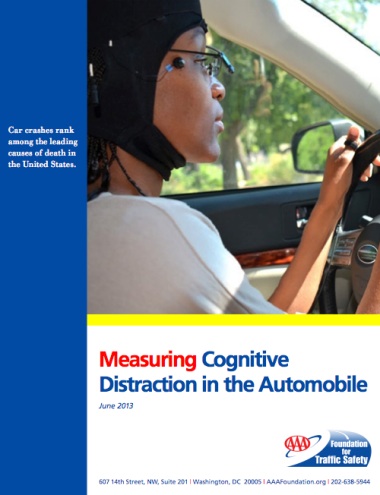
a new report from AAA.
Yesterday the AAA Foundation for Traffic Safety dropped a bomb into the national debate about distracted driving. They conducted research and developed a report that shows “significant levels of cognitive distraction” by people who drive while performing various hands-free tasks. The report comes amid a growing trend in the auto-industry to turn cars into smartphones. In fact, on the same day this report came out, Apple made a big announcement about their new operating system, iOS in the Car, which promises to allow users to, “easily and safely make phone calls, access your music, send and receive messages, get directions and more.”
Part of this push is an attempt by automakers to find a way to rekindle the love affair between young people and cars that has built the foundation of their business for decades. Unfortunately, their sales goals are at odds with the health and welfare of millions of Americans and the new in-car technology arms race they are involved in flies in the face of this new safety research by AAA. Here’s an excerpt about the research from AAA’s blog:
Much more troubling, however, is the fact that phone conversations (whether hand-held or hands-free) and voice-based interactions with in-vehicle systems create significant levels of cognitive distraction, as demonstrated by suppressed brain activity, slowed reaction times, missed visual cues, and reduced visual scanning of the driving environment (think tunnel vision). Keep in mind that these degradations were found even though drivers kept their eyes on the road and, with the exception of the hand-held phone task, their hands on the wheel.
Succinctly put: “hands-free” doesn’t mean “risk free.”
…
Though shipments of these [infotainment] systems are expected to skyrocket in the coming years, use of speech-to-text communications presented the highest level of cognitive distraction of all the tasks we analyzed.
Crash statistics show the importance of this research. Not only are automobile-related crashes one of the leading causes of death and injury in America, but the amount of them caused by driver distraction has reached epidemic proportions. A recent study cited in the AAA report ofund that “inattention” was a factor in 78 percent of all crashes and near crashes. The consequences of all this distracted driving are especially obvious for people who use the road while on a bicycle.
This report has garnered widespread media attention. However, the conventional wisdom is that until there are strong laws (that are actually enforced), the auto industry isn’t likely to change course. For states that care about traffic safety, there’s a clear course of action to consider. Many states have already made using a cell phone while driving illegal; but the next step is to eliminate the exception for hands-free devices. In an editorial back in 2010 we called on the Oregon Legislature to do just that. Hopefully this new research from the AAA will create the political cover needed to finally take that important legal step and put the auto industry on watch to create safer products.

